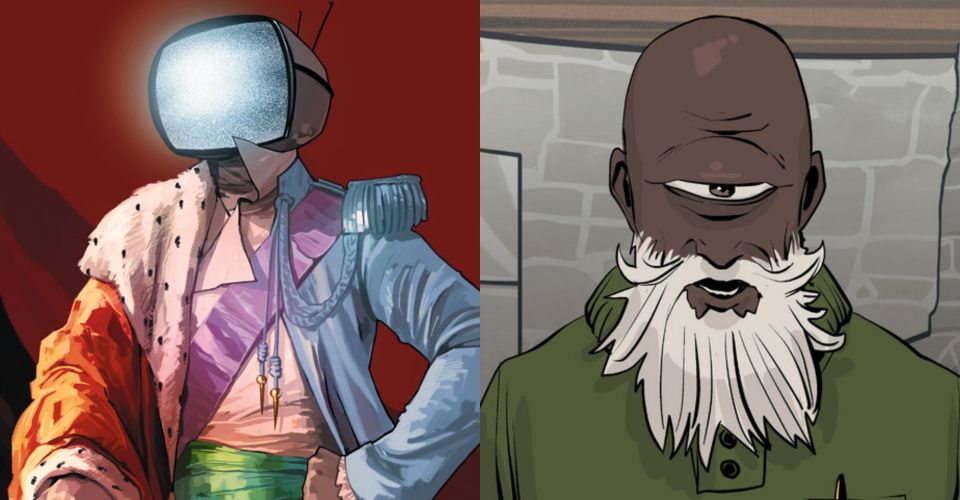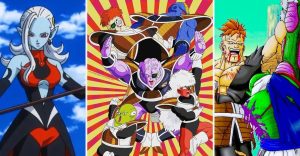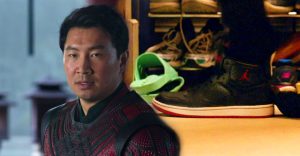Saga: 10 Best Characters From The Comic Series

One of the most captivating aspects of Brian K. Vaughan and Fiona Staples’ comic-book series Saga is its cast of colorful and diverse characters. Saga charts the narrative of two parents from warring species who forgo the endless conflict and set out across the universe to escape it, all while raising their daughter. Along the way, they come in contact with, or are wanted by, a number of different political interests.
Thanks to Vaughan’s writing and Staples’ art, many characters have been able to make a distinct splash both narratively and visually throughout the course of the comic.
Special Agent Gale

Introduced in the first issue, Special Agent Gale represents Alana’s planet Landfall in its attempts to eliminate Alana and Marko so that their union is never revealed to the public. An operative acting on behalf of a powerful government, he hires hitmen, silences journalists, and abets the destruction of a comet with living beings on it.
Gale earns his spot precisely because he represents the establishment within Saga‘s world, a perspective which most of the on-the-run main characters never can. Also, unlike the evil of the killers pursuing Marko and Alana, Gale represents the banal, amoral evil of a privileged core world.
D. Oswald Heist

There would be no Marko and Alana, and therefore no Hazel, without Heist’s books to inspire their courtship, and Heist is kind enough to offer them and their family a safe haven for a short while, an action which results in pain and ultimately death for him.
Having lost a son to the psychological effects of the war, Heist was able to see better than most how senseless the conflict was, and masked his critique of it with stories of faraway fantasy lands. It would be easy to write him off as a simple self-insert for the creators, but his inspiring ability to see the truth gives hope that maybe one day enough civilians can do the same.
Ghüs

Portrayed as a mix of an Arctic seal and a Southern cattle rancher, Ghüs joins up with the mission because he is enlisted to track down his favorite animal, Friendo, which he traded to Alana and Marko in exchange for a powerful axe. He eventually helps Marko and Prince Robot IV reunite with their families thanks to his ability to track Friendo.
While he’s not the breakout character of the story, Ghüs makes an excellent parental figure to Hazel and Squire, and brings a homespun attitude, as well as some welcome cuteness, to the main cast, and his willingness to put his life on the line for Squire is beyond admirable.
Lying Cat

Now she’s the breakout character, able to sense when a character knows they are telling a lie and murmur “lying” when she does so. Lying Cat endears herself because of her ability, but also when she uses it. Whether it be in life-or-death situations or to point out when a character isn’t being honest with themselves, Lying Cat brings support and levity to any situation, and definitely has to come back in Saga‘s second half.
She’s also much more than just a pet, able to assert her own wishes when presented with a choice of staying with Sophie or returning to The Will. The situation is heartwrenching, but the fact that she can make choices like it signal she really is a character in her own right.
Gwendolyn

Although introduced as the ex-fiancée of Marko, Gwendolyn goes far beyond this, and becomes not only a fierce and formidable diplomat in her own right, but a mentor to Sophie, the girl The Will rescued from Sextillion.
Gwendolyn’s increasing importance to Wreath means she turns into their equivalent of Special Agent Gale, but because readers spend much more time with her, they come to understand her motivations and see her advance far beyond a simple revenge quest. If Saga were ever adapted, Gwendolyn is a strong female character who’d deserve her own movie as a spinoff.
The Will

Characterized by Hazel herself as a “f****** MONSTER,” The Will is hired by Wreath in the first issue to kill Marko and Alana, but to bring the newborn Hazel back to Wreath alive and unharmed. However, his mission takes a number of detours until eventually he comes to fatal blows with Marko and Prince Robot.
He is never presented as a morally good character, and although there are times when he does good deeds, his murder of Marko is unforgivable. What earns him his spot is the fact that he is more than a villain, a flawed, broken human being.
Prince Robot IV / Sir Robot

On paper, the idea of a character with a TV set for a head seems ridiculous, but somehow it works incredibly well. Prince Robot IV is enlisted by Landfall to find Marko and Alana, but eventually comes to join them and renounces his title, becoming simply Sir Robot.
Between his gender and sexual fluidity and his war experiences which have left him with post-traumatic stress, Robot earns sympathy by becoming a character who truly is able to reform over the course of his time in the series, which is why his death hits almost as hard as Marko’s.
Alana

Assigned to guard prisoners, one of whom is Marko, Alana instead falls in love with and thus frees him, leading them to go on the run together. She’s strong and independent, tested as both a mother and as a person throughout the first 54 issues. She learns how to use her wings to fly, and what she’s willing to do to protect the ones she loves.
Alana is far from a flawless character, but between her and Marko, she is the one who carries less emotional baggage from her past, and is thus less hesitant to use violence for defense. Her choice of love over an ingrained sense of duty sets the story on its course. Her relationship with her husband, and their struggles with parenthood, makes Saga a great comic for new readers.
Marko

Initially eager to join the war to defend his homeland, Marko quickly becomes disillusioned when he witnesses the true horror and costs of it all, especially when he shoots down a civilian rather than an enemy combatant, leading him to surrender himself to Landfall.
Like Sir Robot, Marko is haunted by his conflict experiences, and goes even further by forswearing the use of violence in any way. Yet, when he must finally resort to violence for defense, he is a natural at it, and that dark side yearns to get out throughout the course of the story, giving readers another complex character shaped by violence. His death on the final panel of Saga issue #54 is also one of the most impactful deaths in comic books.
Hazel

Hazel is almost by default the best character of the series, as it is through her voice that Saga is told in the first place. Her role as narrator is not where she is most important, however; Saga could be told almost as well without her having to narrate a word of it.
No, what makes Hazel the best is what she represents: the possibility of connection, reconciliation, and therefore peace between Wreath and Landfall. She is a child of two cultures. Everything her parents do in Saga is ultimately in service of keeping her safe, which her narration makes clear ultimately works. Saga is truly Hazel’s story.
About The Author

















